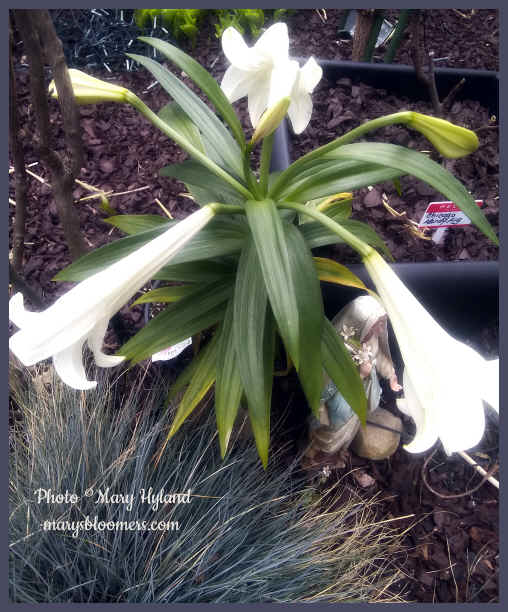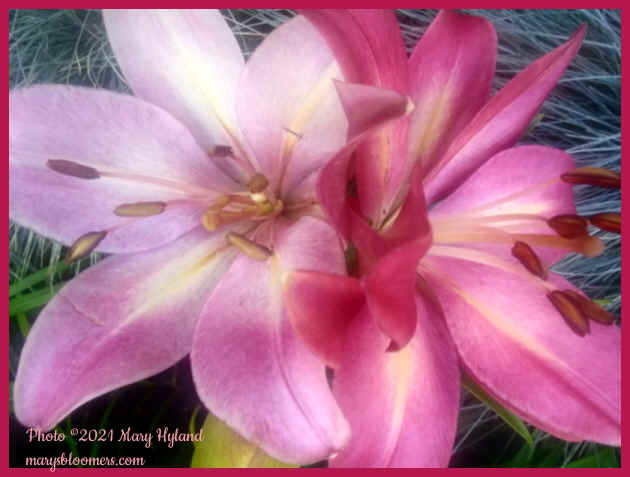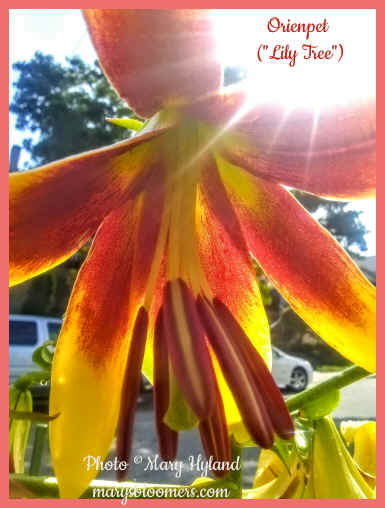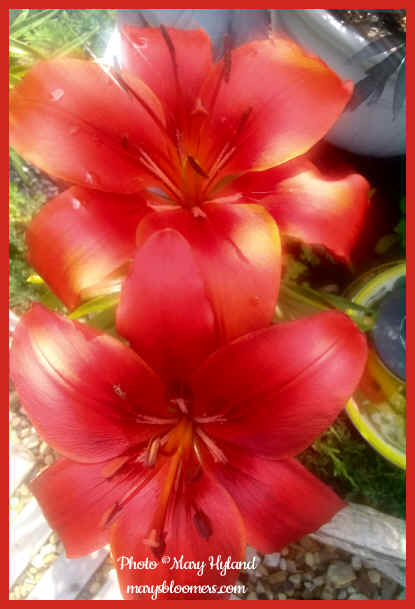| There really
isn't a lot to tell you about growing lilies - they kind of do
it all by themselves. Except for staking the tall varieties, you
can grow them almost anywhere but full shade. They grow best in
full sun and part sun. Rabbits, deer and groundhogs will feast
on them if given the chance. I have a problem with squirrels.
They dig up and eat or steal my bulbs. But they're not
particular about which bulbs.
Such perfect and fragrant
blooms on long stems with distinctive leaves, with little or no
care at all once you pop those bulbs into the ground or into a
decorative Asian-style or modern pot. They're so easy, I
call them "Plant and Stand Back" plants. Lilies
are beautiful, elegant flowers that are well-suited to provide
impact in many garden design themes, e.g., Mary Gardens, Zen
Gardens, Asian/Japanese Gardens, Secret Gardens, Saints Gardens,
Fragrance Gardens, Moonlight Gardens and Cut Flower Gardens.
They are a hit as cut flowers grown for sale at markets and
garden shows. They are also great balcony, terrace and patio
garden ornamental display. Tall stems, dark green interesting
foliage, beautifully-shaped flowers, spectacular
fragrance, zero care, and they take up almost no horizontal
space.
Lilies also look stunning
along fence lines (inside or outside the fence) with the tallest
close enough to the fence to make it easy to stake or tie, if
necessary. I have a row of Tree Lilies growing along the inside
of my front yard's white picket fence for a cottagey look. They
peek over the 4 ft. fence and face the street, so that neighbors
and walkers can enjoy them, too. They finish blooming just
as the old -fashioned Giant Hibiscus, that are also planted
there, are already full of buds and preparing to take their turn
and bloom until frost. Since they're the same height as the
Lilies, it's a rotating flower show of high impact flowers.
In a flower bed, lilies are very friendly,
respects other flowers' space, and prospers in the presence of
low-growing plants that protect the liliesí roots from drying out.
Mine have beautiful and dense ground covers at their feet, like
Snow in Summer, Creeping Jenny and Blue Star Creeper (Amsonia).
Ground covers keep weeds away and fills in any gaps. Soft and
frilly types look like delicate carpets. Let them grow even if
they start to grow over the tops of bulbs in spring - the lilies
will just push right through the soft foliage and stems.
Besides the glorious blooms
that are a feast for the eyes and a treat for the nose, these
elegant beauties attract butterflies and other pollinators, so
add them to your pollinator and butterfly
gardens. If you grow fruit trees and shrubs, lilies
will draw more pollinators into the garden who will happily
pollinate them, and along with the bees, will provide
pollination of fruiting plants that present you with the fruit
feast at harvest time.
 |
Lilies
are not at all fussy. Mine don't seem to get bugs or
disease, and you don't have to prune them. Plant several
varieties, and you can have a long season of lily
blooms. Lilies do well in Zones 4-9. They come in
several heights, from border lilies for the front of the
garden, to tall Tree Lilies (Orienpets) that tower over
fences, you can have three types in your flower garden
blooming at the same time or rotating bloom times from
Spring to Fall. Lilies are perennial and will bring you
joy year after year.

|
In most places, plant lily bulbs in the fall,
a few weeks before the first freeze date. Bulbs planted in fall
will have well-established roots in the spring. Flower bulbs
benefit from a winter chill to produce big blooms. I don't
follow a schedule. I plant them anytime in fall, early and
mid-spring, and they perform beautifully. I have planted in late
spring and still had a big show in summer.
In areas with very harsh winters, plant as soon
as the threat of frost has passed, and the ground is
dig-able in spring. Container-grown lilies can be planted
anytime during spring and early summer. Buy the bulbs
close to planting time because lily bulbs donít go dormant,
and you don't want them to rot while waiting. If I have to wait
to plant my bulbs, I store them in baggies in the veggie drawer
of the fridge for up to 2 weeks.
After planting and during active growth, water
freely, especially if rainfall is less than 1 inch
per week. Lilies love mulch. Keep lilies mulched so that
their roots are cool during very hot weather and to keep water
from evaporating. I use a recycled rubber mulch that stays put
and doesn't decompose or need replacing. Leave a little space
around the stem without mulch. Even in the hottest weather, my
in-ground lilies are fine without watering more than once a
week. Mulching before the first freeze keeps the soil warmer and
allows roots to keep growing a little while longer.
Lilies bloom only once per season, but you can
remove the faded flowers so that the plants donít waste energy
making seeds. You can cut back the stems of spent flowers,
but don't remove leaves until they have died down and
turned brown in fall. Itís important not to cut back the dead
leaves until the end of their season, because they help provide
energy to the bulb for next seasonís blooms. I'll admit I
don't always follow that advice because I don't like dead leaves
on my plants. The bulbs do ok for me if I skipped that part.
Mine look best if I cut the flower stem down to a few inches and
ignore cutting off the leaves. The leaves are actually pretty
attractive on the short stems.
Cut and Place In Vase
I work in, and photograph my gardens and
lilies regularly. Orange/yellow stains are always happening from
the pollen and I end up wearing it. It's amazing how it sticks
to just about anything. I have found groovy yellow and orange
streaks in my hair (from pushing my hair out of my eyes), on my
face and hands, and it stains clothing. I wear a gardening
"uniform" anyway, to make sure I don't ruin my
favorite clothing. I always forget that if I cut the stamens out
from the center of the flower before bringing them inside, I
won't have pollen marks everywhere. New lily varieties are being
developed that don't have that pollen thing going on. Not good
for pollinators, but clothes- and nose-friendly.
Try not to cut off more than a third of your
lily plant's stems with the flowers. Before arranging in a
simple, but classy, tall vase with a wide mouth, strip the lower
leaves on the stems so that no foliage will be underwater.
That causes that rot and brown water thing. A lily arrangement
will last two or more weeks. Mine generally last only a week
because I don't cut until the flowers are fully open. I like
them to stay in the garden as long as possible. Cutting
the lilies just as the buds are opening and you can just see the
flower colors, will give you more time. Change the water every
few days, cutting a little bit off the bottom of the stem
to facilitate water absorption.
Place the vase on top of a colorful placemat
or a pretty vintage doily or runner because once the petals
start to drop, they drop everywhere. I use a small serving tray
with handles that has a raised edge to contain it, and the
handles make it easy to move around without dropping petals all
over.
Types
of Lilies
Asiatic lilies
Asiatic lilies start the lily
blooming season in early to mid summer. Most have upward-facing
flowers and all are hardy in zones 4 to 9. The fragrance has
just about been bred right out of 'em. But they're still
stunning to look at.
Martagons
Martagons are also
known as Turk's cap lilies. Growing 3 to 4 feet tall, they have
3-inch flowers with petals that curve backward (recurved), and
up to 20 blooms on each stem. Turk's Cap Lilies are hardy in
zones 3 to 9.
Trumpet Lilies
Zones 5-9
Mid-summer bloomers named
for their trumpet-shaped flowers. Trumpet lilies produce lots of
flowers (12 to 15 per stalk) and have a heady, sweet fragrance.
3-5 ft. tall.
Trumpet Lilies have two
categories:
Aurelian hybrids can reach 5
feet tall.
Easter Lilies are known for their huge, trumpet-shaped,
outward-facing blooms. Very fragrant.
Orienpet Lilies
A hybrid cross between the oriental ("orien")
trumpet lily and the Trumpet ("pet") lily. Also called
"Tree Lilies", they can reach 7-8 ft. tall.
Upward-facing or hanging blooms and intense, exotic fragrance.
Tiger
Lilies
3 to 4 feet tall with large,
freckled, hanging blooms with recurved (curving backwards)
petals. Tiger lilies are very hardy (zones 3 to 9) and will
multiply to form large clumps over the years. They are happy
anywhere, and can produce more than a dozen blooms on each stem.
Rubrum Lilies
Rubrums resemble the Tiger
Lilies but the color range is from white to deep pink and the
blooms are very fragrant.
Oriental Lilies
The last lilies to bloom are
Oriental Lilies. Intensely fragrant, with very large blossoms up
to 10 inches across. Blooming in mid- to late summer, just when
Asiatic lilies are beginning to fade. From 2-8 ft. tall. The
shorter vrieties are great for patio container gardens.
Treasured for their intoxicating fragrance that intensifies
after dark, Oriental lilies produce masses of huge white, pink,
red, or bi-color blooms. They make wonderful cut flowers that
will fill rooms with their scents. Perfect for Fragrance Garden,
Romantic Garden, Secret Garden, and Moonlight Garden design
themes.

Article and Photos ©2020
Mary Hyland
Mary's Bloomers
All rights reserved
Note: Every part of the lily is said to be
toxic to cats. The cats terrorizing my gardens and killing birds in
flower beds that are filled with lilies and feeders beg to differ. They roll in them, break the stems hunting down birds, and
cover their fur with pollen. I don't own the feral or roaming cats, and
cats are here all the time, so I don't
worry about it. But if you're cautious and your cat has access to your
garden, lilies might not be for you unless your cat is a
homebody.
Detailed
Site Directory-->
Quick
Links
Content, graphics,
photos and design ©2020 marysbloomers.com
All rights
reserved.
|























